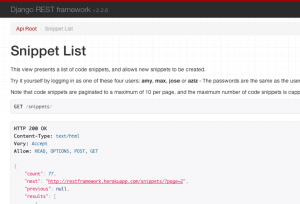Getting Django Rest Framework to parse docstrings as reStructuredText
The Django REST Framework is awesome, for a whole bunch of reasons, one of them being the browsable HTML version of your API that it automatically generates for you.
As a part of this, it extracts any docstrings that you might have defined for the relevant class (ViewSet or CBV) and adds an HTML version of this documentation to the browsable API, like this:
However, as described in the relevant documentation, it expects Markdown syntax by default. I like Markdown, but the rest of my Python docstrings are all in reStructuredText, which is the default documentation format for many Python projects.


